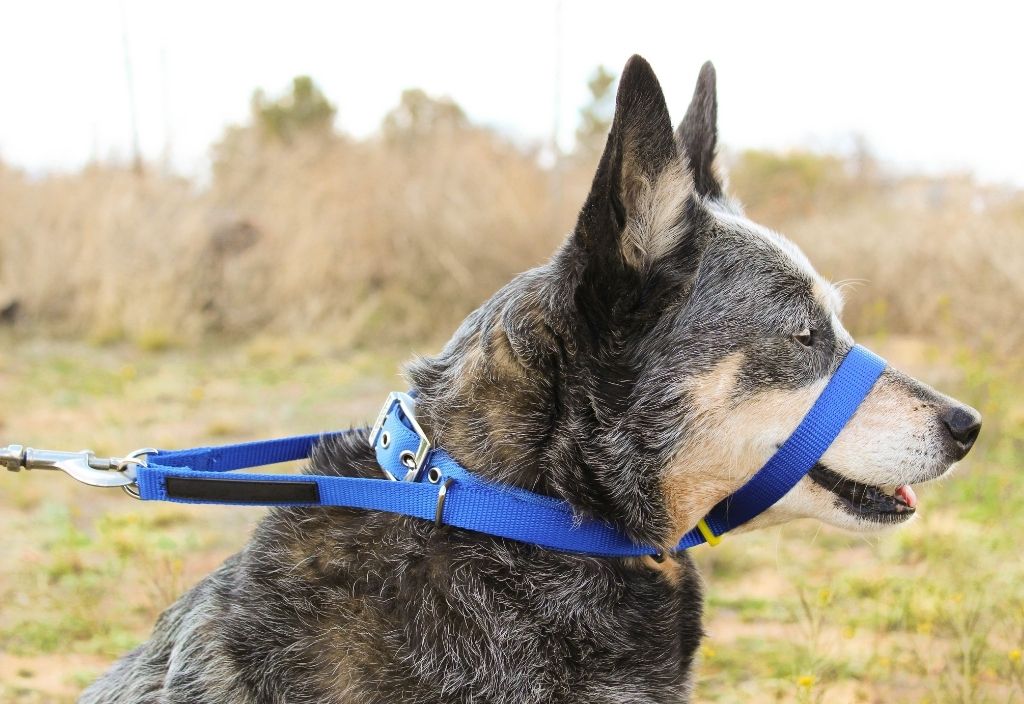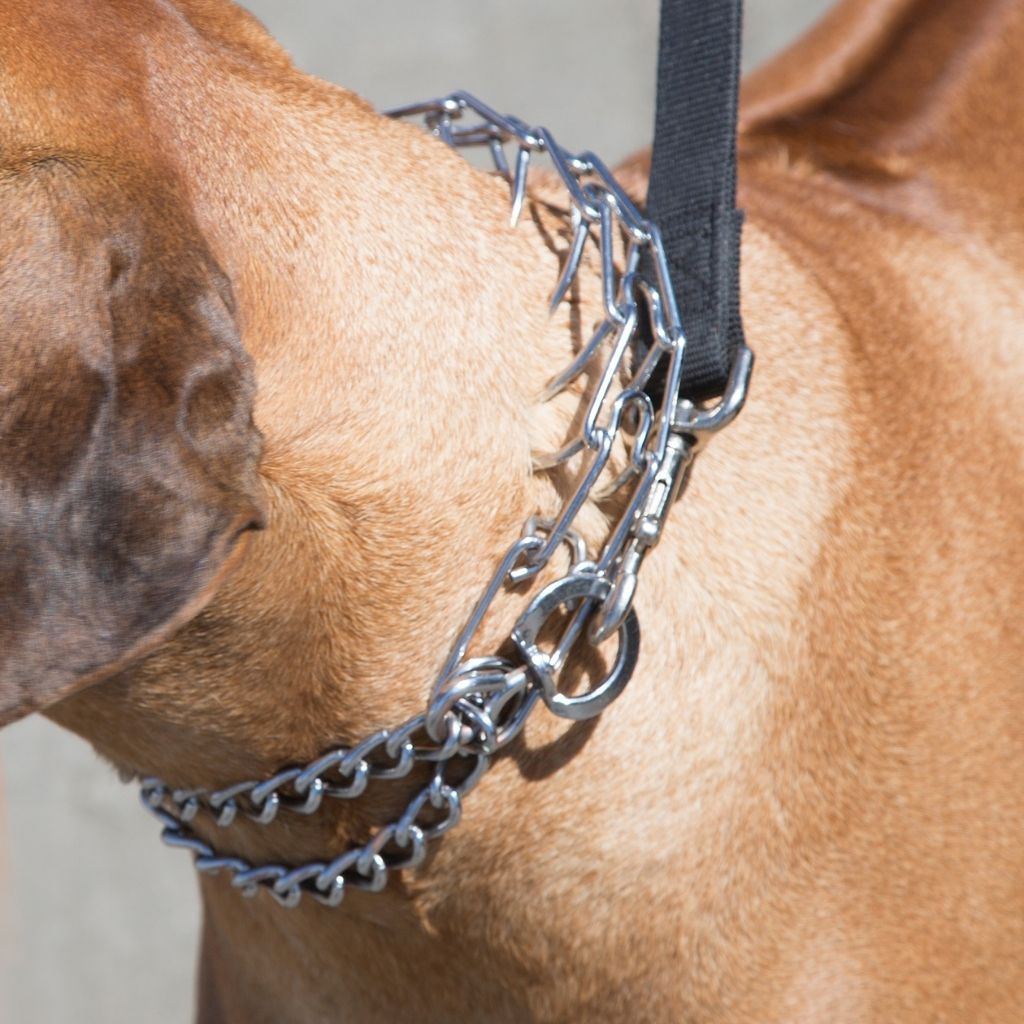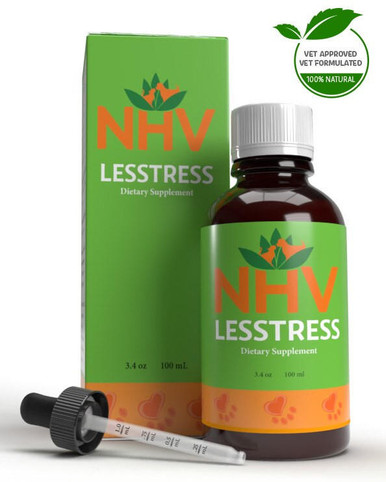stress & anxiety support

free shipping over $100 (USA & Canada)
1-877-937-4372 the pet expert hotline

Herbal Digestive Aid, Energy Booster, and Multivitamin for Dogs


Collars are an essential part of dog ownership. They allow dogs to be identified, they allow pet parents to walk their pooches on a leash and they also provide a proper place to hang important information such as ID, license, and vaccination status, for instance. For many pet parents, getting a collar for your new pet is a rite of passage that marks the official addition of a new furry family member. It can be difficult to know how to choose the right collar for your pet, but that’s why we are here to help!
There are so many styles of collars on the market but not all kinds of collars are appropriate for all dogs. The kind you choose to use and when you use them are very important aspects to have a pleasant experience for both you and your dog and also help avoid serious and even fatal injuries.
When talking about possible complications from collars is when questions such as “Ok, so which type of collar should I choose?” or “Is it true that harnesses are safer than collars?” start popping up. So let’s start with what science tells us about collars and chest harnesses, first.

Some studies like this one found that intraocular pressure increased significantly from baseline when pressure was applied via a collar but not via a harness. That means that dogs with conditions such as glaucoma, or conditions that leave their inner eye pressure higher than normal, should wear a harness instead of a collar, especially during exercise or activity.
Chest harnesses are also recommended for pooches with conditions such as tracheal collapse, laryngeal paralysis, and spinal problems because the harness fits around the dog’s chest and avoids unnecessary pressure on the neck. They limit pull and pressure on the dog’s windpipe and disperse that pull across the front of their body in an even distribution. For that reason, they are also good for dogs that pull or lunge. You just need to be careful with harnesses that are too tight, since a too tight fit could impede circulation in the dog’s front leg.

You should be able to get two fingers comfortably underneath the collar to make sure you found the proper fit.
This is the standard collar for dogs. A flat collar should fit comfortably on the dog’s neck, however, it shouldn’t be too tight nor too loose that they can slip out of it. You should be able to get two fingers comfortably underneath the collar to make sure you found the proper fit.
In terms of health and training, when dogs are allowed to pull on the collar and permitted to sustain the pull, these dogs learn to override it, and by doing so, they are at risk for laryngeal, esophageal, and ocular damage. Unfortunately, most people do not use these collars correctly and this is another reason why their use is so controversial. Thankfully, with time more and more pet owners are preferring a head collar or a chest harness over regular flat collars for their dogs. When used correctly, these devices are much safer and easier to use than the regular flat ones.
Actually, a recent study published in December 2019 intended to assess the pressure and force applied to the dog’s neck when exercising using a collar and leash of different materials. They found out that not only material and design/profile of dog collars, but also the direction of exercise affected the amount of pressure and forces applied to the canine neck. They also found out that the presence of cushioning was not effective in reducing total force and localized pressure on the neck. This is another example of how considering options other than regular flat collars are important, since a suitable collar should reduce load on the dog’s neck and regular flat collars will hardly do that, despite their fabric and/or design.

These collars work for most dogs and are appropriate for all life stages. They spare the dog’s larynx and esophagus, so they can also be used for pooches with conditions such as laryngeal damage, tracheal collapse, or cervical (neck) damage. When this leash is pulled forward or the dog pulls in the direction opposite to that of the leash, part of the collar slightly tightens and applies a small amount of steady pressure on the upper neck area. The head collar is good for strong, energetic dogs who may jump and pull as well.
Dogs fitted with head collars should be able to comfortably eat, drink and pant. It’s important to keep in mind that the head collar must be properly fitted in order to minimize the risk of injuries and some practice might be needed to determine the best adjustment of the neck and the nose straps.

In case you’re considering using a training collar, it’s important to know that there are debates about the relative benefits of using different training approaches with respect to welfare implications and the use of training collars, such as shock collars, for instance.
Training collars should only be used as a last resort when all positive methods of training have been exhausted and failed and when the dog is likely to be euthanized without their use. Unfortunately, these collars can easily be misused by the general public.
There are different methods to train a dog and the World Society for the Protection of Animals (WSPCA) explains that aversive training techniques – which are based on the principle of applying an unpleasant stimulus to inhibit their behavior – can include the use of prong collars and electric shock collars, which can cause discomfort and distress. WSPCA considers these techniques unacceptable from a welfare perspective, and this type of approach is unnecessary for the modification of dog behavior. They state that the use of these techniques can compromise the welfare of dogs, they may worsen behavioral problems, and can even put owners at risk.
Many scientific studies have found an association between the use of aversive training techniques with the occurrence of undesired behaviors in dogs. The WSPCA defends this point of view based on the fact that dog trainers all over the world use reward-based methods to train dogs very effectively without subjecting them to training techniques that may cause discomfort or distress.
The Canadian Veterinary Medical Association (CVMA) has a similar position about the use of humane training methods that are built on current scientific knowledge of learning theory. They mention that methods using positive reinforcement are highly favored and methods causing fear, distress, discomfort, or anxiety are unacceptable.
In fact, a recent study published in July 2020, refuted the suggestion that training with an e-collar is either more efficient or results in less disobedience, even in the hands of very experienced trainers. The researchers found training with positive reinforcement more effective at addressing the target behavior as well as general obedience training. This method of training also posed fewer risks to dog welfare and the quality of the human-dog relationship. The scientists suggested that there is no evidence to indicate that e-collar training is necessary, even for its most widely cited indication. In some places, shock collars can only be used by veterinarians and qualified dog trainers. In New Zealand, the law requires that e-collars can only be used for the training of serious behavioral issues in cases where other training methods have failed and the dog is a candidate to be euthanized because of inappropriate behavior.

Ideally, your pooch should not be wearing collars at home since there are risks of accidents such as strangulation by the collar, especially when they are left alone at home. Factors such as skin allergies and neck damage should also be taken into consideration when deciding to keep your pet wearing a collar at all times as well. It’s also recommended to avoid dangling identification tags in order to prevent incidents. A tag that slips onto the collar and lies flat or collars that have safety information embroidered onto them are much safer options.
Many pet owners defend the use of a collar at home especially when their pets are escape artists and if anything happens and the dog escapes, he/she will have identification on them. Some pet owners also defend that in an event of an emergency where you need to evacuate your place, it’s easier to put the dog on a leash and leave quickly when they are already wearing their collars. These are valid points however, some preliminary studies suggest that the annual amount of accidents such as strangulation by collars are more frequent than most people think. An average of 26,000 collar strangulation accidents occur yearly in homes and establishments in the United States. Crates and kennels, playing with other dogs, fences, heating/cooling vents, shrubs, and branches are a few of the most common strangulation hazards dogs and dog owners face each day.
This is one of the reasons why pet owners should always consider microchipping their pets. Microchips work as a permanent pet ID, it’s about the size of a grain of rice and is injected beneath the surface of the pet’s skin. The process is safe, quick and the microchip will last for the pet’s entire life. In the case your pooch escapes, collars can be taken off and ID tags can be lost, but a microchip underneath your doggo’s skin can’t be removed and will help identify the pet later on.
We hope this post could help you and your little one to live a loving, healthy, and safe life together! If you are still wondering about how to choose the right collar for your pet, it’s a good idea to chat with your veterinarian or you can ask our pet experts for more tips.
stress & anxiety support

Natural Support for Canine Stress and Anxiety
buy 2 and save $3
3 month supply for a small to medium size pet
What is it?
Everyone knows what stress feels like, and we all know that too much stress can make us ill—high blood pressure, ulcers and even cancer can result from excessive stress. Like us, dogs can get stressed by numerous factors as well. Help your furkiddo relax into a long and happy life with NHV Lesstress - a natural dog stress support.
How does it work?
Why trust it?
NHV uses full-spectrum extracts of human-grade herbs, so your pet only gets the best.


What is it?
Everyone knows what stress feels like, and we all know that too much stress can make us ill—high blood pressure, ulcers and even cancer can result from excessive stress. Like us, dogs can get stressed by numerous factors as well. Help your furkiddo relax into a long and happy life with NHV Lesstress - a natural dog stress support.
How does it work?
Why trust it?
NHV uses full-spectrum extracts of human-grade herbs, so your pet only gets the best.

Natural Dog Stress Reliever Supplemental Support
With a heightened sense of hearing and smell, small events that seem mundane to us can be terrifying and stressful for your dogs. Sometimes the stress is from the ride to the office, or maybe they are missing their human companions. This all contributes to changes in behavior like excessive panting, drooling, sweaty paws, dilated eyes, pacing, excessively shedding, or just completely shutting down. Some dogs become so stressed that it may lead to fear and aggression.
Other forms of stress in a dog’s life include:
In addition to panting, excessive barking/whining, chewing on themselves, shivering (when it’s not cold), panicked tail wagging, or tense muscles, stress can also cause GI tract issues such as diarrhea or vomiting.
The key to a healthy pup is balance. Too much or too little activity can be harmful, as well as too much or too little socialization. A balanced, clean diet also helps maintain the body and the mind. If your dog is susceptible to stress, you can use calming herbs like those found in NHV Lesstress. This formulation gently acts on the nervous system and immune system to provide a natural dog stress reliever.
How NHV’s Natural Dog Stress Relief Eases Stress and Anxiety
For stressful experiences such as separation anxiety, the loss or addition of a furry friend, special events (eg. fireworks) and illness (stress can cause conditions to worsen), the natural (non-addictive) sedative properties of Lesstress gently relax the nervous system and endocrine system. Ingredients like Chamomile, Passion Flower and Lemon Balm work to calm nerves while ingredients like Reishi, Eleuthero, and Echinacea Angustifolia are very beneficial for helping the body adapt to stress and illness and stimulate healthy immune function.
Help Support Your Dog Naturally
All NHV supplements like Lesstress are 100% natural and created by a holistic veterinarian and a master herbalist, specially formulated for pets. Feel free to contact our veterinary professionals to get more insight into your little one’s health and wellbeing.
Made with the finest, organically grown, or ethically harvested herbs. Made specifically for pets, vet-formulated and vet approved.
Lesstress for Dogs
Select your pet's weight to determine the correct dose.
To be taken twice daily. Determine your pet’s weight and then use the easy chart below to determine the correct dose. This is the minimum dosage.
Pet's Weight Dosage
0 - 15 lb = 0.5 ml
16 - 30 lb = 1.0 ml
31 - 45 lb = 1.5 ml
46 - 60 lb = 2.0 ml
61 - 75 lb = 2.5 ml
Over 75 lb = 3.0 ml
For small animals (rabbits, ferrets), avians and reptiles use 1 drop for every 2 lb of body weight.
How to Administer
Shake well before use.
The easiest method is to use the dropper provide and places the drops into your pet’s food or favorite treat. You can also use the dropper and squirt directly into the pet’s mouth.
Some pets can be finicky, if this occurs consider hiding the drops in foods most pet’s love such as fish, chicken or yogurt or a favourite treat. If your pet only eats dry food then soak a few kibbles at feeding time.
For Best Results
Herbal dietary supplements are beneficial to the health and wellbeing of your pet and are safe for long-term use. Every pet responds to natural herbal supplements differently, therefore it is important to be consistent and administer the product daily. Supplements generally take two to four weeks to take effect, however this will vary from one animal to the next.
Product Storage
All NHV Natural Pet Products are pure herbal extracts and contain no artificial additives, preservatives or coloring. Shelf life after opening is 6 months and must be refrigerated after opening.
Cautions and Contraindications
Do not use Lesstress in pregnant or nursing animals.
Speak to your vet before using our products. A second visit is recommended if your pet’s condition does not improve, or deteriorates after continued use of the supplements.
All information provided by NHV Natural Pet Products is for educational purposes only.
Natural Dog Stress Reliever Supplemental Support
With a heightened sense of hearing and smell, small events that seem mundane to us can be terrifying and stressful for your dogs. Sometimes the stress is from the ride to the office, or maybe they are missing their human companions. This all contributes to changes in behavior like excessive panting, drooling, sweaty paws, dilated eyes, pacing, excessively shedding, or just completely shutting down. Some dogs become so stressed that it may lead to fear and aggression.
Other forms of stress in a dog’s life include:
In addition to panting, excessive barking/whining, chewing on themselves, shivering (when it’s not cold), panicked tail wagging, or tense muscles, stress can also cause GI tract issues such as diarrhea or vomiting.
The key to a healthy pup is balance. Too much or too little activity can be harmful, as well as too much or too little socialization. A balanced, clean diet also helps maintain the body and the mind. If your dog is susceptible to stress, you can use calming herbs like those found in NHV Lesstress. This formulation gently acts on the nervous system and immune system to provide a natural dog stress reliever.
How NHV’s Natural Dog Stress Relief Eases Stress and Anxiety
For stressful experiences such as separation anxiety, the loss or addition of a furry friend, special events (eg. fireworks) and illness (stress can cause conditions to worsen), the natural (non-addictive) sedative properties of Lesstress gently relax the nervous system and endocrine system. Ingredients like Chamomile, Passion Flower and Lemon Balm work to calm nerves while ingredients like Reishi, Eleuthero, and Echinacea Angustifolia are very beneficial for helping the body adapt to stress and illness and stimulate healthy immune function.
Help Support Your Dog Naturally
All NHV supplements like Lesstress are 100% natural and created by a holistic veterinarian and a master herbalist, specially formulated for pets. Feel free to contact our veterinary professionals to get more insight into your little one’s health and wellbeing.
Made with the finest, organically grown, or ethically harvested herbs. Made specifically for pets, vet-formulated and vet approved.
Lesstress for Dogs
Select your pet's weight to determine the correct dose.
To be taken twice daily. Determine your pet’s weight and then use the easy chart below to determine the correct dose. This is the minimum dosage.
Pet's Weight Dosage
0 - 15 lb = 0.5 ml
16 - 30 lb = 1.0 ml
31 - 45 lb = 1.5 ml
46 - 60 lb = 2.0 ml
61 - 75 lb = 2.5 ml
Over 75 lb = 3.0 ml
For small animals (rabbits, ferrets), avians and reptiles use 1 drop for every 2 lb of body weight.
How to Administer
Shake well before use.
The easiest method is to use the dropper provide and places the drops into your pet’s food or favorite treat. You can also use the dropper and squirt directly into the pet’s mouth.
Some pets can be finicky, if this occurs consider hiding the drops in foods most pet’s love such as fish, chicken or yogurt or a favourite treat. If your pet only eats dry food then soak a few kibbles at feeding time.
For Best Results
Herbal dietary supplements are beneficial to the health and wellbeing of your pet and are safe for long-term use. Every pet responds to natural herbal supplements differently, therefore it is important to be consistent and administer the product daily. Supplements generally take two to four weeks to take effect, however this will vary from one animal to the next.
Product Storage
All NHV Natural Pet Products are pure herbal extracts and contain no artificial additives, preservatives or coloring. Shelf life after opening is 6 months and must be refrigerated after opening.
Cautions and Contraindications
Do not use Lesstress in pregnant or nursing animals.
Speak to your vet before using our products. A second visit is recommended if your pet’s condition does not improve, or deteriorates after continued use of the supplements.
All information provided by NHV Natural Pet Products is for educational purposes only.
overall vitality

For Overall Health and Well-Being
buy 2 and save $3
What is it?
Support your dog’s health with omega-3 fish oil for dogs, promoting a healthy coat, eyes, joints, immune system, and overall organ function.
How does it work?
Why trust it?
NHV Petomega 3 has earned 5-star ratings by pet parents from around the world.


What is it?
Support your dog’s health with omega-3 fish oil for dogs, promoting a healthy coat, eyes, joints, immune system, and overall organ function.
How does it work?
Why trust it?
NHV Petomega 3 has earned 5-star ratings by pet parents from around the world.

Our omega 3 fish oil for dogs is a great source of EPA (Eicosapentaenoic Acid 600mg) and DHA (Docosahexaenoic acid 460mg) essential fatty acids. This fish oil supplement for dogs is derived from sardines, anchovies and North Atlantic cod liver oil. It is molecularly distilled and cold pressed to improve the bioavailability of the omega 3 fatty acids, and is medical and human grade quality.
Omega 3 fish oil for dogs may be beneficial for the following:
Processed pet foods have increased omega-6 fatty acids, and decreased omega-3 fatty acids. The University of Maryland Medical Center states, "It is very important to maintain a balance between omega-3 and omega-6 fatty acids in the diet. A proper balance helps maintain and even improve health." Your dog’s body cannot easily make essential fatty acids. It is vital to provide omega 3 fish oil for dogs as an added supplement to your pet’s daily diet.
The American Journal of Veterinary Medicine has published studies on the benefits of omega 3 fatty acids (fish oils) for arthritis and degenerative joint disease in dogs. The studies showed that dogs who were given omega 3 fatty acids had a significantly improved ability to get up from a resting position and marked improvement in walking ability.

Suggested Dosage: To be taken once per day. Add to food based on weight chart.
Therapeutic Dosage: Double the quantity for maximum period of 4 weeks or follow veterinarian advise.
Pet’s Weight Dosage
0-15 lb = ¼ tsp
15-30 lb = ½ tsp
30-60 lb = 1 tsp
60-90 lb = 1 ½ tsp
How to Administer: Shake well before use. The easiest method is to add the dosage to your pets food. Some pets can be finicky, if this occurs consider hiding the appropriate amount in food most pet’s love such as fish, chicken, yogurt, or a favorite treat. If your pet only eats dry food then soak kibbles at feeding time.
For Best Results
Dietary supplements are beneficial to the health and well-being of your pet and are safe for long-term use. Every pet responds to natural supplements differently, therefore it is important to be consistent and administer the product daily. Supplements generally take two to four weeks to take effect, however this will vary from one animal to the next.
Product Storage
All NHV Natural Pet Products contain no artificial additives, preservatives or coloring. Shelf life after opening is 6 months and must be refrigerated after opening.
Cautions and Contraindications
Avoid During Pregnancy.
Our omega 3 fish oil for dogs is a great source of EPA (Eicosapentaenoic Acid 600mg) and DHA (Docosahexaenoic acid 460mg) essential fatty acids. This fish oil supplement for dogs is derived from sardines, anchovies and North Atlantic cod liver oil. It is molecularly distilled and cold pressed to improve the bioavailability of the omega 3 fatty acids, and is medical and human grade quality.
Omega 3 fish oil for dogs may be beneficial for the following:
Processed pet foods have increased omega-6 fatty acids, and decreased omega-3 fatty acids. The University of Maryland Medical Center states, "It is very important to maintain a balance between omega-3 and omega-6 fatty acids in the diet. A proper balance helps maintain and even improve health." Your dog’s body cannot easily make essential fatty acids. It is vital to provide omega 3 fish oil for dogs as an added supplement to your pet’s daily diet.
The American Journal of Veterinary Medicine has published studies on the benefits of omega 3 fatty acids (fish oils) for arthritis and degenerative joint disease in dogs. The studies showed that dogs who were given omega 3 fatty acids had a significantly improved ability to get up from a resting position and marked improvement in walking ability.

Suggested Dosage: To be taken once per day. Add to food based on weight chart.
Therapeutic Dosage: Double the quantity for maximum period of 4 weeks or follow veterinarian advise.
Pet’s Weight Dosage
0-15 lb = ¼ tsp
15-30 lb = ½ tsp
30-60 lb = 1 tsp
60-90 lb = 1 ½ tsp
How to Administer: Shake well before use. The easiest method is to add the dosage to your pets food. Some pets can be finicky, if this occurs consider hiding the appropriate amount in food most pet’s love such as fish, chicken, yogurt, or a favorite treat. If your pet only eats dry food then soak kibbles at feeding time.
For Best Results
Dietary supplements are beneficial to the health and well-being of your pet and are safe for long-term use. Every pet responds to natural supplements differently, therefore it is important to be consistent and administer the product daily. Supplements generally take two to four weeks to take effect, however this will vary from one animal to the next.
Product Storage
All NHV Natural Pet Products contain no artificial additives, preservatives or coloring. Shelf life after opening is 6 months and must be refrigerated after opening.
Cautions and Contraindications
Avoid During Pregnancy.
skin and coat health


Holistic Dog Fur Care and Skin Supplement
What is it?
Coco Furcare for Dogs also helps deter external parasites, helps reduce itching and irritation from skin allergies, and keeps your dog’s coat sleek and healthy, all while keeping your pup smelling fresh and clean.
How does it work?
Why should I trust it?
NHV uses human-grade herbs that are safe if licked.


What is it?
Coco Furcare for Dogs also helps deter external parasites, helps reduce itching and irritation from skin allergies, and keeps your dog’s coat sleek and healthy, all while keeping your pup smelling fresh and clean.
How does it work?
Why should I trust it?
NHV uses human-grade herbs that are safe if licked.

Dog coat and skin supplements like Coco Furcare can help improve the shine and luster of your dog’s beautiful fur. Coco Furcare has natural ingredients that soothe the skin, deterring your pet from scratching themselves raw and leaving their skin open to infection. Protection against parasites and skin allergens also reduces itching and the possibility of future hot spots for your dog.
This spray-on supplement is formulated with powerful, all-natural ingredients like Neem leaf, sodium bicarbonate, and Eucalyptus. These ingredients have potent anti-inflammatory, antibacterial, and anti-pest properties that stop the source of any itching and soothe any irritation.
Coco Furcare is also made with ingredients like chamomile for a calming effect, moisturizers like cedarwood, and deodorizers such as lemongrass. All of these natural extracts help to provide comprehensive and effective care for your pet’s skin and coat.
Improper dog fur care and bites from pests like mites and fleas can result in a hot spot. Hot spots occur when a dog itches or obsessively grooms aggravated skin until the area is raw. The introduction of bacteria to the irritated area causes an itchy, infected sore. Hot spots can result in discomfort and induce hair loss. Left untreated, the wound can grow into a severe health concern.
NHV’s dog coat and skin supplements are formulated by veterinarians and herbalists with 20+ years of experience. Call our pet expert hotline and find solutions to your pet’s health concerns.
How to Apply
Lightly spray your pet from back of ears to tail, taking care to avoid the eye area. Brush through coat, repeat as needed.
For Best Results
Herbal dietary supplements are beneficial to the health and well-being of your pet and are safe for long-term use. Every pet responds to natural herbal supplements differently, therefore it is important to be consistent and administer the product daily.
Product Storage
All NHV Natural Pet Products are pure herbal extracts and contain no artificial additives, preservatives or coloring. Shelf life after opening is 2 years and refrigeration not required
Cautions and Contraindications
Avoid contact with eyes. In case of contact with eyes flush thoroughly with water. Keep out of reach of pets and children to avoid possible consumption. Do not use in pregnant or nursing animals. Speak to your vet before using our products. A second visit is recommended if your pet’s condition does not improve, or deteriorates after continued use of the supplements.
All information provided by NHV Natural Pet Products is for educational purposes only.
Dog coat and skin supplements like Coco Furcare can help improve the shine and luster of your dog’s beautiful fur. Coco Furcare has natural ingredients that soothe the skin, deterring your pet from scratching themselves raw and leaving their skin open to infection. Protection against parasites and skin allergens also reduces itching and the possibility of future hot spots for your dog.
This spray-on supplement is formulated with powerful, all-natural ingredients like Neem leaf, sodium bicarbonate, and Eucalyptus. These ingredients have potent anti-inflammatory, antibacterial, and anti-pest properties that stop the source of any itching and soothe any irritation.
Coco Furcare is also made with ingredients like chamomile for a calming effect, moisturizers like cedarwood, and deodorizers such as lemongrass. All of these natural extracts help to provide comprehensive and effective care for your pet’s skin and coat.
Improper dog fur care and bites from pests like mites and fleas can result in a hot spot. Hot spots occur when a dog itches or obsessively grooms aggravated skin until the area is raw. The introduction of bacteria to the irritated area causes an itchy, infected sore. Hot spots can result in discomfort and induce hair loss. Left untreated, the wound can grow into a severe health concern.
NHV’s dog coat and skin supplements are formulated by veterinarians and herbalists with 20+ years of experience. Call our pet expert hotline and find solutions to your pet’s health concerns.
How to Apply
Lightly spray your pet from back of ears to tail, taking care to avoid the eye area. Brush through coat, repeat as needed.
For Best Results
Herbal dietary supplements are beneficial to the health and well-being of your pet and are safe for long-term use. Every pet responds to natural herbal supplements differently, therefore it is important to be consistent and administer the product daily.
Product Storage
All NHV Natural Pet Products are pure herbal extracts and contain no artificial additives, preservatives or coloring. Shelf life after opening is 2 years and refrigeration not required
Cautions and Contraindications
Avoid contact with eyes. In case of contact with eyes flush thoroughly with water. Keep out of reach of pets and children to avoid possible consumption. Do not use in pregnant or nursing animals. Speak to your vet before using our products. A second visit is recommended if your pet’s condition does not improve, or deteriorates after continued use of the supplements.
All information provided by NHV Natural Pet Products is for educational purposes only.
Published: February 20, 2021